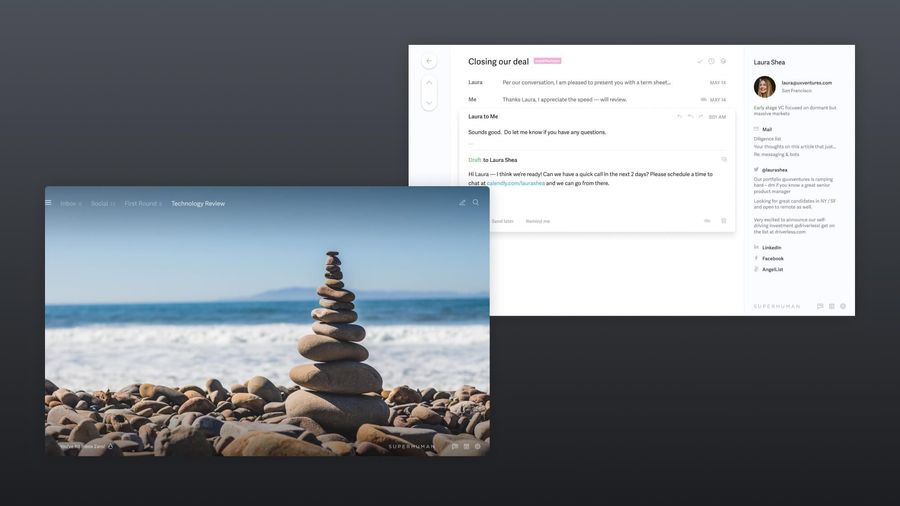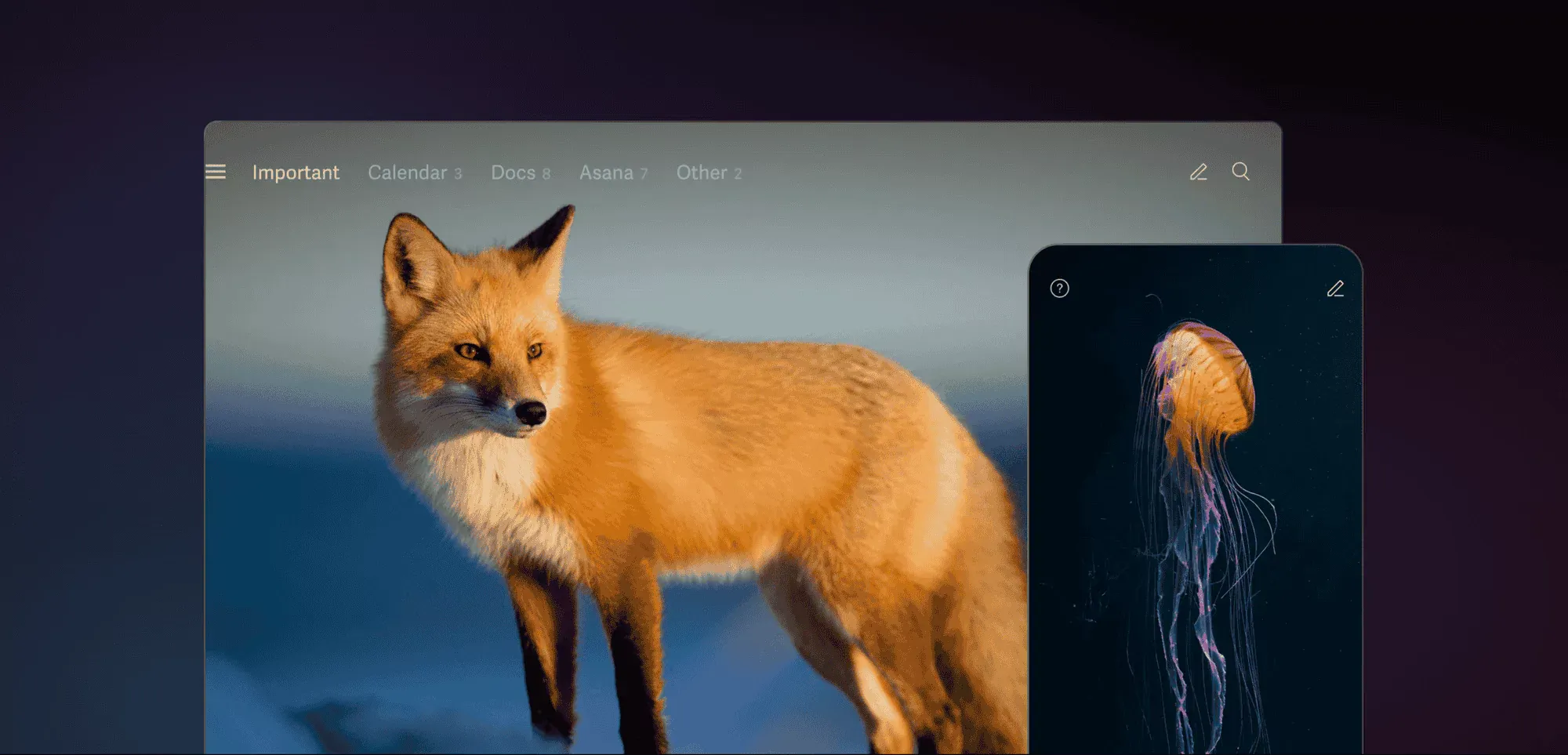
Microsoft Outlook ranks among the most popular email clients, especially among schools, businesses, and enterprises. Available in desktop and mobile versions, Outlook is compatible with Windows and Apple operating systems. However, it lacks the performance, user experience, support, and reliability of newer, more dynamic email clients.
This guide includes eight Outlook alternatives suitable for every inbox need — from basic free options like Gmail to the most productive email app ever made, Superhuman, which will save you four hours every single week.
Top 8 Outlook alternatives (free and paid)
Here are the top eight free and paid Outlook alternatives:
- Gmail
- Superhuman
- eM Client
- ProtonMail
- Front
- Spark
- Mozilla Thunderbird
- Spike
Our list of the best Outlook alternatives includes numerous options to fit several different email needs. Honorable mentions like Zoho Mail and Mailbird didn't make our list, but they're also worth checking out.
1. Gmail
Chances are, if you're not using Outlook or Apple Mail, your email address probably ends in "gmail.com." Google's email service is free and packed with features that are standard to most email providers. Better yet, Google separates personal and professional with Google Workspace, a business suite that builds on Gmail's basic features list.
Gmail incorporates tasks, categories, spam filters, a priority inbox, and the ability to snooze emails into its capabilities.
In addition, Google Workspace offers professionals an ad-free email address complete with a website builder, extra storage, team collaboration, file sharing, custom domains, and advanced security. Gmail add-ons include Google Drive, Chat, Meet, Docs, Sheets, Slides, and Google Calendar.
Google's email service wins big points if you want to manage multiple Gmail addresses from one dashboard, but linking external accounts can be problematic. Top features — such as advanced search, enhanced security, and an integrated calendar — are isolated to paying Google Workspace clients.
Check out our Gmail vs. Superhuman comparison to explore more features of both services.
2. Superhuman

What if you could achieve an organized inbox in just 15 minutes a day using the Inbox Zero method? Superhuman is the fastest email experience ever made. Fly through your inbox and save four hours every single week.
Superhuman works seamlessly with your existing Outlook account and works wherever you do.
Split Inbox allows you to triage emails faster and focus on what matters most, and Superhuman Command settles the debate of which is faster: keyboard vs. mouse. Meanwhile, Superhuman for Sales helps sales teams win more deals.
Leverage Snippets and Superhuman AI to draft emails in your tone and voice. Ask AI can even give you rapid answers without having to comb through messages, while Auto Summarize provides a 1-line summary above every conversation. Plus, Shared Conversations & Team Comments allow you to collaborate where work actually happens — directly in your inbox.
3. eM Client
Similar to Gmail and Outlook, eM Client offers Windows and macOS compatibility. However, it lacks a mobile app, leaving accessibility on desktop only. Unique features include a built-in calendar, contact management, notes, chat function, and more.
The free version of eM Client allows you two email addresses and a support forum. You must upgrade to unlock additional features, such as email snoozing and scheduling. eM Client also integrates with Dropbox, OneDrive, Google Workspace, and Zoom.
Regarding security, eM Client ranks as one of the few on our list that supports Pretty Good Privacy (PGP) encryption. This type of encryption allows for increased email security and privacy for messages, digital signatures, and files. eM Client also works well with iCloud, Gmail, AOL, and Yahoo! Mail.
4. ProtonMail
Located in Switzerland, ProtonMail uses zero-access, end-to-end encryption based on the zero-knowledge encryption standard. This email client abides by Swiss privacy laws as its servers are located in Switzerland. ProtonMail was built by MIT and CERN scientists, but you don't need an advanced degree to use or benefit from it.
With the ProtonMail free plan, users receive 500MB of storage, 150 daily messages, and three folders/labels. ProtonMail won't support professional email in most cases, as it doesn't offer the option of a custom domain name.
You can unlock advanced features with paid plans — monthly or annually — and additional applications like ProtonCalendar, ProtonDrive, and ProtonVPN.
5. Front
Teams looking for a collaborative tool will find Front a viable Outlook alternative. This customer communication platform allows for customer service and email messaging from one place. Think of it as a team collaboration tool and ticketing system in one.
Front features include robust analytics, a shared inbox, assignments, contact management, automated workflows, chat, and "@" mentions. You can also view 360-degree customer data to track performance and customer satisfaction.
Front also integrates with social channels and third-party tools to keep you and your team connected.
6. Spark
Spark is another team collaborative option to explore if you're working from a shared email inbox. With Spark, you can delegate, snooze, and sort emails. Smart Inbox routes emails to your designated folders, and additional features include scheduling, tasks, templated responses, and email reminders.
Accessing Spark's premium features — such as shared drafts, shared inboxes, and team roles — requires upgrading to a paid plan. However, this Outlook alternative does offer a clean design that lends itself to more productive and efficient collaboration. Spark is also compatible with Windows and macOS.
7. Mozilla Thunderbird
As a free and open-source email client, Mozilla Thunderbird may not earn high marks for the design interface, but it does offer a customizable look, basic functionality, add-ons, and extensions.
Thunderbird is compatible with Windows and Apple operating systems, but it lacks a mobile app. Users who want to connect their email to project management platforms or productivity tools like Asana or Trello will also find Thunderbird lacking.
However, Mozilla makes up for this with plenty of basic features augmented by extensions and add-ons. For example, the platform includes a Mail Account Setup Wizard, Smart folder, Tabbed Email, and Large Files Management. Additional features include phishing protection, an address book, a Quick Filter toolbar, and an add-ons manager.
8. Spike
Last on our list but hardly least, Spike is an email client that caters to email users who prefer a more chat-focused inbox.
Instead of the standard letter-type display, emails are converted to chat bubbles and brought together with communications, tasks, and calls for greater ease of use and accessibility. This email client prioritizes simplicity and collaboration for a more streamlined experience.
Notable Spike features include real-time chat and video calls, live collaboration, note sharing, tasks, Intelligent Priority Inbox, custom templates, instant messaging, and reminders. Using this email client does require a slight learning curve, but spending some time with it should get you up to speed without much delay. Spike is available for mobile and desktop applications.
Enhance your email experience with Superhuman
Amongst these eight Microsoft Outlook alternatives, you're bound to find an option that suits your needs and heightens your email experience.
Superhuman is the most productive email app ever made. It integrates seamlessly with Gmail and Outlook accounts. Fly through your inbox twice as fast and save four hours per week, every single week.
Sign up for Superhuman today.


